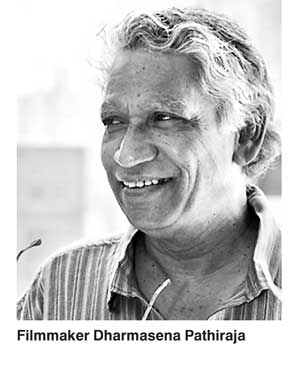Thursday Nov 20, 2025
Thursday Nov 20, 2025
Saturday, 1 July 2017 00:00 - - {{hitsCtrl.values.hits}}
Is there a single person in Sri Lanka who can be called a cinematographer or a filmmaker, in the professional sense of the word? Is there anyone who earns his living solely through films? Is there a film industry in Sri Lanka?
These questions were raised by one of the seniors in the local film scene during a felicitation organised by the Government Information Department and the National Film Corporation. The organisers had a catchy title for the ceremony – ‘Pathita Panahai’.
Filmmaker Dharmasena Pathiraja is well known. He is popularly known in the shortened form of his name, ‘Pathi’. No one makes a mistake about it. 
‘Panahai’ created a bit of a problem. Some wondered whether he was 50 years old. Anyone doing a quick calculation about his film-making would have realised that he should be older. But how many do? Not even media men, as Pathi himself sarcastically mentioned during his short speech.
“I got a telephone call a few days back. The caller identified himself as one from a FM channel. ‘Hello, is that Dharmasena?’ he asked me. I remained silent. Then he asked, ‘Haven’t you completed 50 years?’ Again I didn’t answer. In a way I should have said ‘Yes – 25 years back’.”
Obviously the media man hadn’t done the basics. Surely a journalist interviewing someone should at least study the background of the person. These are first lessons we learnt as cub reporters doing on-the-job training at a time when there were no courses, diplomas or degrees on ‘mass communication’ – a term unknown in our era.
The celebration was because Pathi had completed 50 years in the field of cinema. He was humble enough to admit that this was the first time he was celebrating (more appropriately – being celebrated). “I had never even celebrated my birthday,” he said at the start.
He confessed that he had not made a whole lot of films during his 50-year career. Not more than about 10 films, he said. He reminded how after directing ‘Soldadu Unnehe’ in 1980, he was quiet for many years until Tissa Abeysekera, during his tenure as Chairman of the Film Corporation, requested him to do one.
“I didn’t earn my living by making films,” he said. “I became a lecturer in the Vidylanakara University in 1968. Until I retired from the Colombo University in 2008 that was my profession.”
Pathi is convinced that there is a lot of young talent in the country. Thus a need for the authorities to provide the necessary facilities and encourage them to make quality films. “roviding capital is most essential. Give them the necessary infrastructure,” he appealed. President Maithripala Sirisena was listening in the audience.
‘Rebel with a cause’
As for Pathi’s contribution, it’s not the quantity that matters, but the quality. What he did, quality-wise was far above average. That is why we still talk of his early films – ‘Ahas Gauwa’ (1974), ‘Eya Dan Loku Lamayek’ (1977), ‘Bambaru Avith’ (1978), ‘Para Dige’ (1980) and ‘Soldadu Unnahe’ (1981). He has also created interesting tele-dramas like ‘Elle Langa Walauwwa’.
‘Bambaru Avith’ was slotted number four among the best films produced in the first 50 years of Sinhala cinema. Pathi wrote the script, dialogues and screenplay, and directed the film. Apart from his own highly-commendable effort, Premasiri Khemadasa’s music score and Donald Karunaratne’s photography were ranked high. Set in the backdrop of a fishing village, the acting of Vijaya Cumaratunga, Joe Abeywickrema and Malini Fonseka won critical praise.
It’s appropriate to quote the introductory para of the chapter devoted to Pathi titled ‘Towards a socially-engaged cinema’ in ‘Profiling Sri Lankan Cinema’ (Wimal Dissanayake and Ashley Ratnavibhushana 2000):
“In the late 1960s Dharmasena Pathiraja appeared on the Sri Lankan cinematic landscape as a rebel with a cause. He wanted to break out of the constrictive formats of Sri Lankan cinema and strikeout in new and more fruitful directions. He was deeply perturbed by haze of ossifying orthodoxy, both of filmmaking and opinion that was settling over the local film culture. He wanted to create new cinema that proposed a counter-discourse to the bourgeois artistic cinema and the formula-based popular cinema of the time.
“Much like filmmakers in Latin America in the sixties, his was a desire inspired by theory. He wanted to expose how society confronts us with its own lies and compel a new urgency to speak through his cinematic images. He was also keen to indicate to us the manifold ways with which we inhabit our culture and institute a complex seeing that it would interrogate the ruling modes of viewing and undercover the ideological complicities of cinematic representation. Not that Pathiraja succeeded in achieving all his noble ambitions; nevertheless, his effort was highly significant and ushered in a new era in Sinhalese cinema.”